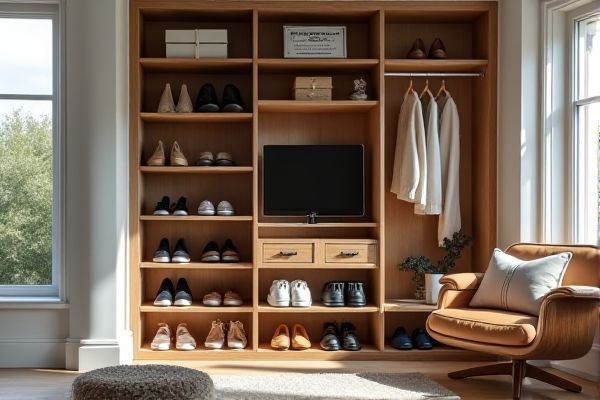
A shoe shelf offers open, easily accessible storage ideal for quickly grabbing your shoes, while a shoe cubby provides individual compartments that keep pairs neatly separated and organized. Discover which option best suits Your space and shoe collection as you read the rest of the article.
Table of Comparison
| Feature | Shoe Shelf | Shoe Cubby |
|---|---|---|
| Design | Open shelves, horizontal layout | Compartmentalized, vertical or grid layout |
| Storage Capacity | Varies; good for multiple pairs on open display | Specific slots for individual shoes; organized storage |
| Accessibility | Easy to view and access all shoes | Shoes stored per compartment; slightly less immediate access |
| Space Efficiency | Requires more horizontal space | Optimizes vertical space with compact layout |
| Visual Appeal | Showcases shoes prominently | Offers neat, clean organization |
| Best Use | Daily use, displaying favorite shoes | Organized storage for multiple pairs |
| Common Materials | Wood, metal, plastic | Wood, plastic, fabric bins |
Introduction to Shoe Storage Solutions
Shoe shelves provide open storage with easy visibility, allowing you to quickly grab your favorite pair, while shoe cubbies offer individual compartments that help keep your shoes organized and protected from dust. Both options maximize closet space efficiently, but shoe cubbies are ideal if you want to separate and categorize different types of footwear. Choosing the right storage depends on your available space and how you prefer to display or conceal your shoe collection.
What is a Shoe Shelf?
A shoe shelf is a flat, horizontal surface designed to neatly store and display footwear, often found in closets or entryways. It maximizes vertical space by allowing multiple pairs of shoes to be stacked or lined up in an organized manner. Shoe shelves are typically adjustable or fixed and can be made from materials like wood, metal, or plastic to fit various storage needs.
What is a Shoe Cubby?
A shoe cubby is a storage unit designed with multiple small compartments to organize individual pairs of shoes neatly, maximizing space efficiency. Unlike a shoe shelf, which usually features open horizontal surfaces, a cubby provides defined slots that prevent shoes from piling up and make it easier to quickly locate your footwear. This design is ideal for maintaining order and protecting shoes from damage in entryways or closets.
Shoe Shelf: Key Features and Benefits
Shoe shelves offer an open, flexible storage solution that maximizes visibility and accessibility, making it easy to quickly find and grab footwear. Their simple design supports various shoe sizes and types, promoting airflow that helps prevent odors and moisture buildup. Ideal for entryways or closets, shoe shelves enhance organization while saving space without the bulkiness of enclosed units.
Shoe Cubby: Key Features and Benefits
Shoe cubbies offer individual compartments that keep your footwear organized, preventing clutter and making it easier to find specific pairs quickly. Designed to maximize storage in compact spaces, shoe cubbies protect shoes from dust and damage while maintaining ventilation. Your entryway or closet benefits from their structured layout, enhancing both functionality and aesthetic appeal.
Space Efficiency: Shoe Shelf vs Shoe Cubby
Shoe shelves maximize vertical space by allowing multiple pairs to be stacked or arranged on open tiers, making them ideal for narrow or tall storage areas. Shoe cubbies provide individualized compartments that keep shoes organized and prevent overlap, but they can occupy more floor or wall space due to their box-like structure. For tight spaces, shoe shelves offer greater flexibility and higher capacity, while shoe cubbies excel in neatly separating shoes for easy access.
Organization and Accessibility Comparison
Shoe shelves provide open, horizontal surfaces that allow shoes to be displayed and accessed quickly, making them ideal for visual organization and easy retrieval. Shoe cubbies consist of individual compartments, offering segmented storage that minimizes clutter and keeps pairs neatly separated, enhancing orderliness. Choosing between the two depends on whether priority is given to visibility and ease of grabbing or to structured, compartmentalized storage that reduces mix-ups.
Style and Aesthetic Considerations
Shoe shelves offer a sleek, minimalist look that displays footwear elegantly, making them ideal for modern or contemporary interiors. Shoe cubbies provide a more structured, compartmentalized design that enhances organization while adding a casual or rustic charm to your space. Your choice between these options should align with your overall decor style and the visual impact you want to achieve.
Suitability for Different Shoe Types
Shoe shelves are ideal for displaying a variety of shoe types, including high heels, sneakers, and boots, as they offer open, flat surfaces that accommodate different shapes and sizes. Shoe cubbies provide individual compartments that are perfect for organizing smaller footwear like flats, sandals, or children's shoes, keeping pairs neatly separated. Your choice depends on the diversity of your shoe collection and the level of organization you desire.
Choosing the Best Option for Your Needs
Shoe shelves offer open storage with easy access and visibility, ideal for quickly grabbing your favorite pairs, while shoe cubbies provide individual compartments that keep shoes organized and prevent them from toppling over. If you prioritize maximizing space and maintaining a neat appearance, your choice should depend on the size of your collection and available floor area. Assess your footwear habits to determine whether the accessibility of shelves or the compartmentalization of cubbies better suits your lifestyle.
 homyna.com
homyna.com